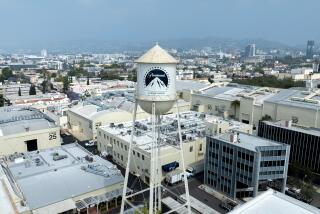America’s Richest Man Backs Chatsworth Laser Disc Company : Videos: The chairman of Metromedia Co. is ‘enthused,’ his attorney says, about the ‘technology and the applications’ used by Image Entertainment.
Martin Greenwald, chairman and chief executive of Image Entertainment Inc., which markets and distributes laser videodiscs, has a small pillow hanging on his office wall in Chatsworth. It reads: “Happiness is positive cash flow.”
The pillow was given to Greenwald by John Kluge, ranked by Forbes magazine as America’s wealthiest individual with a net worth exceeding $5.2 billion. Above the pillow is a framed message from Kluge and his partner, Stuart Subotnick, that says: “Please don’t sleep on this.”
Greenwald says he’s wide awake and has big plans for Image. Although Image lost $203,687 in the nine months ended Dec. 31 on $18.5 million in revenue, Greenwald said the company will soon report its first annual profit, for the fiscal year ended March 31. By 1995, he expects Image to churn out $300 million in annual revenue.
Kluge, the chairman of Metromedia Co., apparently believes him because Kluge and Subotnick own 37.1% of Image, and their investment of $9.5 million has paid off so far. At Image’s current stock price of about 80 cents a share, their stake has a market value of about $45.2 million.
“Without John Kluge’s involvement, this company would have been a blip,” Greenwald admitted.
What does the 75-year-old Kluge see in Image?
Kluge is “enthused about the laser disc technology and the applications that Image is making of it,” said Kluge’s attorney, Arnold Wadler.
Greenwald said Kluge, regarded by many in the investment community as a visionary for his early investments in broadcasting and cellular phones, was driven to invest in Image by “the same mentality that got him involved with cellular and paging operations.” Kluge also has a stake in many of the movies that appear on laser disc: He owns 70% of Orion Pictures.
Laser videodiscs are to video what compact discs are to audio. Laser discs, 12-inch optical recordings that look like large compact discs, offer crisper, cleaner sound and pictures far superior to those produced by videotape. Also, unlike tape, which loses quality each time it is played, discs literally don’t wear out.
Laser discs, which retail at $29.95, also cost less than some videotapes. Although prices of videotapes are coming down as the industry increasingly encourages buying over renting, some tapes still sell initially for prices as high as $90.
But videotape still has advantages over laser discs. Owners of videocassette recorders can record their own tapes, while laser disc analysts say recordable laser disc players are still years away. Also, a good VCR can be purchased for $200, while laser disc players still average about $500.
The laser disc market so far remains tiny compared with videotape. Even though laser disc players have been available for home use for about 10 years, only about 350,000 U.S. homes own one, Greenwald said. That compares with nearly 70 million households that have VCRs, according to the Electronic Industries Assn., a Washington trade group.
But association spokesman Mark Rosenker said, “The ‘90s might be the decade of the laser videodisc.”
Gordon Anderson, editor of Special Situations Report, an investment newsletter, said the $50-million to $60-million laser disc market could grow to $600 million over the next several years as prices for players continue to fall, more retail outlets offer laser discs and consumers interested in collecting movie and music videos become increasingly aware of laser.
Another auspicious sign for the industry, Anderson said, is the entrance of Sony Corp., the Japanese consumer electronics powerhouse that recently acquired Columbia Pictures, into the laser disc market. Sony recently modified a compact disc plant in Indiana to produce laser discs.
Despite its small size, Image has established itself as one of the industry’s two dominant players since entering the business more than five years ago. Its biggest competitor, Pioneer LDCA Inc., the Long Beach unit of Japanese consumer electronics giant Pioneer Electronics Corp., also makes laser disc players and is the biggest manufacturer of discs.
Image expects to sell 2.4 million discs this year, compared with the 7 million Pioneer expects to sell.
David Wallace, Pioneer LDCA’s marketing manager, said Pioneer welcomed Image’s emergence in the industry because competition is needed to help the market grow. Pioneer even helped Image by offering it favorable deals to manufacture its discs. But it was Image’s sealing of long-term, exclusive licensing agreements with studios such as Orion, New World and MGM, that secured Image’s position in the industry, Wallace said.
Under these deals, Image gives the studio anywhere from 15% to 40% of the sales of the discs, depending on volume, in exchange for the exclusive rights to market their films on disc.
“It was a very clever move on their part,” Wallace said. “Until then, they were a very small factor in the business. But as a self-preservation move, we had to do it too.”
Greenwald said the licensing deals don’t guarantee Image’s future. In fact, he said, Image is often compared with Vestron Inc., a videotape distributor that went public with much fanfare in 1985 at $13 a share but has since collapsed to less than $1 a share as the company continues to lose money.
Vestron’s downfall has been largely attributed to the move by studios into distributing their own videos once they recognized the potential size of the market. It could be an ominous sign for Image that two studios--Warner Brothers and MCA/Universal--currently distribute their own laser discs.
But Greenwald predicted that studios won’t get into laser distribution en masse. One reason, he said, is that Vestron merely acted as a middleman between the studios and other companies that actually distributed the product. Image does its own marketing and distributing, Greenwald said.
Image had an unusual birth. Greenwald, 48, had worked as a stockbroker in New Jersey for several years before moving to Los Angeles and starting Miracle Film Distributors, which sold X-rated films.
In 1981, Greenwald got a call from Meyer Blinder, the Denver-based penny stock promoter who is currently under federal indictment for stock and wire fraud, charges he denies. Blinder asked Greenwald if he would be interested in buying Key International Film Distributors, a pornographic film distributor on the verge of bankruptcy.
Greenwald put together a group of investors, bought Key for $150,000 and funneled Miracle product through Key for a few years. In 1984, Greenwald heard about laser disc technology while on a trip to Japan.
Again, Greenwald turned to the adult film market, initially distributing X-rated fare on laser discs. “But we realized this was not the direction we wanted to go in nor the focus of attention we wanted to get from the outside world,” he said.
Greenwald renamed the company and began pursuing the licensing deals with Hollywood studios. But Image, which had barely $6 million in revenue at the time, needed about $1 million to advance to the studios for the rights to market their films on disc.
Greenwald was then introduced to Subotnick, who, after hearing Greenwald’s presentation about laser video, said, “We’re interested.” Since then, Greenwald said, “Stu and John have effectively funded the growth of this company.”
Greenwald said he’s also interested in chasing the potential of laser video for educational and industrial applications. To keep on the cutting edge of developments in laser, Greenwald said Image has purchased a stake in North Communications, a Santa Monica firm that develops uses for laser disc technology.
He’s also spending $1 million to build a new editing facility at the Chatsworth plant that will allow Image to make its own master laser discs. That move will save Image about $100,000 a month, he said.
Will Greenwald’s faith in the future of laser video pay off? “That’s the real risk,” said Jonathan Steinberg, publisher of Special Situations Report. “Is this the right technology?”
More to Read
The biggest entertainment stories
Get our big stories about Hollywood, film, television, music, arts, culture and more right in your inbox as soon as they publish.
You may occasionally receive promotional content from the Los Angeles Times.











